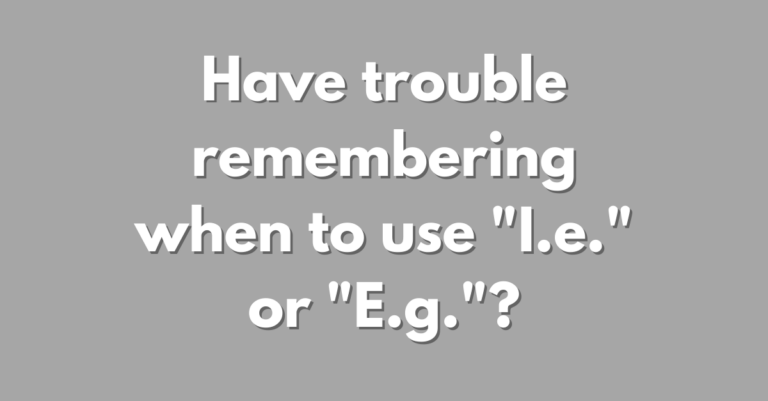Misusing these two abbreviations is one of the top five mistakes I used to see when editing technical documents. There’s so much confusion that in some of the drafts I got back from clients they had actually crossed out the right abbreviation and replaced it with the wrong one. I just had to laugh.
What Do I.e. and E.g. Mean?
I.e. and e.g. are both abbreviations for Latin terms. I.e. stands for id est and means roughly “that is.” E.g. stands for exempli gratia, which means “for example.” “Great. Latin,” you’re probably thinking. “How am I supposed to remember that?”
How to Remember the Difference Between I.e. and E.g.
But by now, I’m sure you know that I’m not going to ask you to remember Latin. I’m going to give you a memory trick. So here’s how I remember the difference. Forget about i.e. standing for “that is” or whatever it really means in Latin. From now on, i.e., which starts with i, means “in other words,” and e.g., which starts with e, means “for example.” I = in other words. E= example.
A few listeners have also written in to say that they remember the difference between i.e. and e.g. by imagining that i.e. means “in essence,” and e.g. sounds like “egg sample,” and those are good memory tricks too.
So now that you have a few tricks for remembering what the abbreviations mean, let’s think about how to use them in a sentence.
E.g. means “for example,” so you use it to introduce an example: I like card games, e.g., bridge and crazy eights. Because I used e.g., you know that I have given you a list of examples of card games that I like. It’s not a finite list of all card games I like; it’s just a few examples.
On the other hand, i.e. means “in other words,” so you use it to introduce a further clarification: I like to play cards, i.e., bridge and crazy eights. Because I used i.e., which introduces a clarification, you know that these are the only card games that I enjoy.
Here are two more examples:
Squiggly loves watching old cartoons (e.g., DuckTales and Tugboat Mickey). The words following e.g. are examples, so you know that these are just some of the old cartoons that Squiggly likes.
Squiggly loves watching Donald Duck’s nephews (i.e., Huey, Dewey, and Louie). The words following i.e. provide clarification: they tell you the names of Donald Duck’s three nephews.
An important point is that if I’ve failed, and you’re still confused about when to use each abbreviation, you can always just write out the words “for example” or “in other words.” There’s no rule that says you have to use the abbreviations.
Dos and Don’ts
Don’t italicize i.e. and e.g.; even though they are abbreviations for Latin words, they’ve been used for so long that they’re considered a standard part of the English language. Also, remember that they are abbreviations, so there is always a period after each letter.
Also, I always put a comma after i.e. and e.g. I’ve noticed that my spell checker always freaks out and wants me to remove the comma, but five out of six style guides recommend the comma. Seriously. I got so engrossed in the question of whether a comma is required after i.e. and e.g. that I made a table for the website summarizing the opinions of six different style guides.
| Source | Recommendation |
| Chicago Manual of Style | A comma is usually used after i.e. and e.g. |
| Blue Book of Grammar and Punctuation | Commas are preferable/optional after the abbreviations. |
| The Columbia Guide to Standard American English | [Editors] require a comma after the second period [in these abbreviations]. |
| The Guide to Grammar and Writing | The comma [following i.e. and e.g.] makes good sense. |
| Lynch Guide to Grammar | Both abbreviations should be followed by a comma. |
| Fowler’s Modern English Usage | Commas do not usually follow i.e. (No comment on e.g.) |
Nevertheless, even though I prefer the comma and have sources to back me up, they almost all use hedge words like “usually” and “preferred.” I’ve also been told that the commas are used less frequently in Britain, and the only style guide I found that advised against commas was Fowler’s Modern English Usage, which has its roots in British English. The bottom line is that in American English, I recommend using a comma after i.e. and e.g. You could probably make an argument for leaving it out in some cases, but do so at your own risk. My personal rule is to use a comma every time.
Finally, I tend to reserve i.e. and e.g. to introduce parenthetical statements, but it’s also perfectly fine to use i.e. and e.g. in other ways. You can put a comma before them, or if you use them to introduce a complete sentence that follows after another complete sentence, you can put a semicolon before them. You can even put an em dash before i.e. and e.g. if you are using them to introduce something dramatic. They’re just abbreviations for words, so you can use them in any way you’d use the words in essence or for example.
Sample Sentences
- I like fun examples, so here are some extras that didn’t make it into the show.
- 1. Our pet, Squiggly (i.e., the snail we brought home after the lab experiments were finished), loves to curl up on his little patch of grass.
- 2. Our pet snail, Squiggly, loves vegetation (e.g., grass, leaves, twigs).
Clean up your writing with Grammar Girl’s book
 “I.e.” versus “e.g.” is just one of the many confusing word choices that Mignon Fogarty covers in the “Dirty Words” chapter of her book, Grammar Girl’s Quick and Dirty Tips for Better Writing. Get the book by clicking this link.
“I.e.” versus “e.g.” is just one of the many confusing word choices that Mignon Fogarty covers in the “Dirty Words” chapter of her book, Grammar Girl’s Quick and Dirty Tips for Better Writing. Get the book by clicking this link.
You can order a copy of the paperback edition from any of these online retailers or pick one up at your favorite bookstore:
The book is also available in an e-book edition. You can download a copy wherever e-books are sold.




